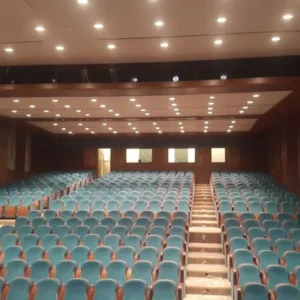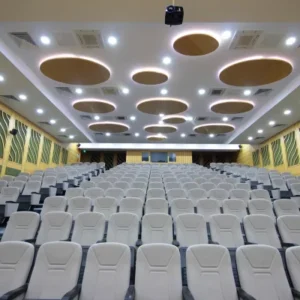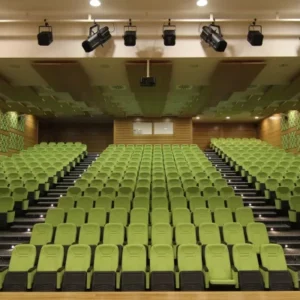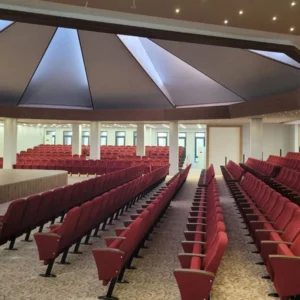Choosing chairs for auditoriums isn’t just about filling a space with seats. It’s about creating a lasting impression, enabling comfort during long events, and ensuring operational functionality that supports a venue’s purpose for years to come. Whether you’re managing a theater renovation, sourcing for a government tender, or designing a world-class conference venue, the decisions you make now will echo through every performance, seminar, and gathering.
But what truly defines a well-informed chair purchase for an auditorium? What details separate a successful installation from one full of headaches?
Let’s dive into the real considerations behind selecting the right seating system—because professionals like you already know: it’s far more than just picking a color and sending a PO.
Table of Contents
The Backbone of Venue Success: Chairs for Auditoriums
At the heart of any public venue is its seating system. Without functional, audience-ready chairs for auditoriums, the entire operation can falter—be it a concert hall, educational institution, or municipal assembly hall.
Today’s venue demands go beyond surface-level needs. Professionals are now considering airflow between chairs, ease of deep cleaning, sound absorption features, and even the recyclability of understructures. Why? Because global trends are shifting toward sustainability and user-centric experience.
Have you ever considered how your auditorium chairs affect venue acoustics?
It’s not just about sound insulation on walls. Chair upholstery, density, and bottom panel perforations all play into echo control. A properly engineered seat can help reduce reverb and increase speech intelligibility by over 30%.
When selecting seating for your auditorium, you’re not just buying products—you’re investing in an ecosystem of interaction, logistics, and user satisfaction.

Navigating the Landscape of Auditorium Seating
The category of auditorium seating is wide and diverse. From fixed tip-up seats to beam-mounted structures, understanding where your project fits within that range helps narrow down ideal models quickly.
Fixed vs. Modular Systems
Fixed seating is ideal for large venues requiring long-term durability and low maintenance. However, modular systems can provide flexible layouts and are preferred in multi-purpose spaces. For instance, if your venue doubles as both a conference hall and performance theater, modular designs can be a game changer.
Seating Density & Sightlines
The ideal row spacing varies depending on usage. For high-traffic venues, 100–105 cm (39–41 in) between rows ensures smooth access. Always consider sightline studies, especially for sloped or stepped floors. Seating misalignment can cost the venue thousands in reconstruction.
Upholstery & Fire Codes
Textile selection isn’t about visuals alone. Flame-retardant ratings such as BS 5852 or CA TB117-2013 compliance should be checked for each fabric. Many auditorium chair suppliers now offer certified materials as a standard, making this easier than ever.
What Makes the Best Seats for Auditoriums?
“Best” is subjective—but for professional buyers, it often means longevity, maintenance ease, and operational functionality. When evaluating seats for auditoriums, professionals look for:
- Replaceable components (armrests, foam blocks, fabric covers)
- Anti-panic writing tablets
- Ventilated seat bottoms for thermal regulation
- Polypropylene back shells with anti-scratch coatings
Did you know well-designed auditorium seats can last over 20 years with only minimal part replacements every 7–8 years?
Maintenance predictability matters—especially in venues with constant use.
When Venue Seating Chairs Must Go Beyond the Basics
Venue seating chairs must adapt to different usage types: governmental buildings, religious halls, universities, or entertainment venues. Each demands tailored specifications.
For Government or Municipal Halls
Priorities often include local compliance codes, anti-vandalism measures, and long-term warranties. Procurement cycles tend to be longer, so product availability and delivery timelines from auditorium furniture wholesale vendors become crucial.
For Performing Arts or Concert Spaces
Acoustics and lighting integration dominate. Many concert hall chairs today offer built-in LED aisle lighting, wire management, and even seat numbering with programmable controls.
Can auditorium chairs be part of your venue’s smart tech system?
Yes! Custom chairs with integrated NFC chips are now being used for real-time seat tracking and crowd analytics in premium venues.
Designing with Purpose: Custom Auditorium Chairs
Standard is rarely enough. Custom auditorium chairs allow full control over foam density, seat height, back angle, and panel finishes. Architects and interior designers often push boundaries, requiring curved-row configurations, gradient color patterns, or even illuminated edge trims.

Partnering with suppliers who offer 3D mockups, sample delivery, and CAD integration can save weeks in planning. Consider requesting full mockup rows before production—it helps avoid costly misalignments during auditorium chair installation.
Bulk Auditorium Seating: Managing Procurement Like a Pro
Purchasing bulk auditorium seating demands a strategic approach. Beyond per-unit cost, decision-makers must factor in:
- Container load optimization
- Regional shipping regulations
- On-site installation logistics
- After-sales part support
How can you reduce installation delays in bulk seating projects?
Request pre-numbered packaging and include layout-specific assembly manuals. These simple additions can speed up installation by 20–30%.
Also, remember to review your auditorium seating prices based on lifetime value, not just upfront cost. A cheaper seat with no after-sales support can quickly become the most expensive option in the long run.
Sourcing Durable Auditorium Seating That Lasts
Durability doesn’t only come from thick metal frames or reinforced plastics. Real strength lies in design precision, smart joint systems, and usage forecasting. Leading auditorium chair suppliers now use fatigue-tested mechanisms with over 200,000 tip-up cycles guaranteed.
- Powder-coated frames reduce corrosion risk.
- UV-resistant polymers prevent discoloration in sunlit venues.
- High-resilience PU foam maintains shape over 10+ years.
Can your seating survive 10 years of student use, weekly deep cleans, and summer humidity?
That’s the benchmark. Always ask for real-world test data when comparing manufacturers.

Exploring Auditorium Chair Design Innovations
Modern venues require seating systems that reflect their vision. Current auditorium chair design trends focus on:
- Acoustic panel integration
- Seamless underseat storage
- Zero-noise mechanisms for lecture halls
- Ergonomic armrest modules with USB ports
Many professional buyers have also begun opting for modern auditorium seats with breathable mesh backs and antimicrobial coatings—especially in medical or educational environments.
Final Thoughts on Purchasing Auditorium Seating
Making the right call when buying chairs for auditoriums is a multi-layered task. It blends architectural foresight, operational practicality, and financial strategy. As global competition rises, venues are pushing for smarter seating systems—ones that are user-friendly, durable, and technically aligned with modern standards.
Whether you’re seeking classic wood-paneled rows or smart-enabled seating for 1,000 guests, having a clear understanding of design, supply, and installation processes can make all the difference. Collaborate with proven auditorium chair suppliers, ask detailed questions, and never underestimate the power of good seating in shaping audience experience.










